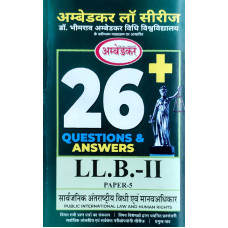- BA
- BA One Week Series(Rajasthan) HINDI Medium
- BA ONE WEEK SERIES (JNVU) HINDI MEDIUM
- BA ONE WEEK SERIES (JNVU) ENGLISH MEDIUM
- BA One Week Series(Rajasthan, Brij, Matsya, shekhawati) English Medium
- BA One Week Series(Shekhawati) HINDI Medium
- BA One Week Series(Shekhawati) English Medium
- BA ONE WEEK SERIES (UNIVERSITY OF KOTA) ENGLISH
- BA ONE WEEK SERIES (MDS) ENGLISH MEDIUM
- BA ONE WEEK SERIES (MGSU) ENGLISH MEDIUM
- BA UNSOLVED PAPER (RU)
- BA TEXT BOOKS
PAPER-2.5 Public International Law & Human Rights (Question-Answer Series) H सार्वजनिक अंतरास्ट्रीय विधि एंव मानव अधिकार
PAPER-2.5 Public International Law & Human Rights (Question-Answer Series) H सार्वजनिक अंतरास्ट्रीय विधि एंव मानव अधिकार
Rs. 65.00 Rs. 130.00
Inclusive Tax: Rs. 65.00
Inclusive Tax: Rs. 65.00
Ambedkar LLB 2nd Year (Question-Answer Series) Public International Law & Human Rights (सार्वजनिक अंतरास्ट्रीय विधि एंव मानव अधिकार)
The book prepared according to following syllabus Question-Answer Format in Hindi Medium.
PAPER 2.5. PUBLIC INTERNATIONAL LAW AND HUMAN RIGHTS
SCHEME OF PAPER: MAX. MARKS: 100 MIN. PASS MARKS: 36
(1) There shall be ten questions in the examination paper, two questions from each unit. The candidate is required to attempt five questions, one question from each unit is compulsory. All questions carry equal marks. (2) The prescribed syllabus includes latest amendments and relevant judgments in the subject wherever applicable.
OBJECTIVES OF THE COURSE: This course is designed in such a way that it covers both theoretical and practical aspects of International Law. This course provides an insight into Public International Law and its significance in the economically globalised world. It enables the students to understand the interdependence of the countries and how they are constantly addressing the global issues through peaceful measures. This course would help the students to understand both the theoretical framework and the working of international law. Understanding of these basic principles is a prerequisite for those students who seek to explore their career or academic interest in specific fields of international law. In view of the gaining significance of International Law of Human Rights, this course presents subtly an overview of the National and International perspectives of Human Rights along with the redressal mechanism.
UNIT - I
Definitions; Development and Nature; Public and Private International Law;
Legality of International Law: Positive Morality; Basic Theories: Naturalist, Positivist, Grotius and Consent Theory; Sources and Subjects of International Law; Theories: Realistic, Fictional, Functional, Monistic, Dualistic; Specific Adoption Theory; Transformation Theory; Delegation Theory; International Law and Municipal Law: Concept of State; Essential Ingredients and Kinds of States; Territory of State; War, its Legal Character and Effects; The Law of Neutrality: Basis, Role, Rights and Duties of Neutral States;
UNIT - II
State Recognition and Succession:
De Facto and De Jure; Theories of Recognition: Recognition of Government, Belligerency and Insurgency; Collective Recognition; State Jurisdiction; Territorial Sovereignty; Responsibility of States: Original and Vicarious; State Responsibility for various Acts: State Succession: Theories of State Succession; Rights and Duties arising out of State Succession; Law of Treaties: Concept and Kinds of Treaties; Binding Force of Treaties; Pacta Sunt Servanda; Jus Cogens; Clausula Rebus Sic Stantibus; Parties of a Treaty; Formation of a Treaty; Reservations; Invalidity and Termination of Treaties; Vienna Convention on the Law of Treaties;
UNIT - III
Law of the Sea: Concepts of Mare Liberum and Mare Clausum; The Anglo Norwegian Fisheries Case and Its After Math; The Technological Revolution and the Utilization of the new resources of the sea; Population Explosion and Its Impact; Changing Concepts of Maritime Frontiers: Territorial Sea, Contiguous Zone, Continental Shelf& Exclusive Economic Zone, High Seas; Territorial Waters and Contiguous Zone; Principles for Determination of Maritime Frontiers And Maritime Boundaries under the Customary and Conventional Law; Exploitation of Deep Sea: Bed Resources: International Sea Bed Authority;
UNIT - IV
Individuals under International Law and International Institutions:
Position of Individuals; Nationality and Citizenship; Diplomatic Agents: Powers and Functions; Theories and Immunities; Asylum; Extradition; Relationship and difference between Extradition and Asylum; International Institutions: United Nations (U.N.): History and Formation of U.N., Charter of U.N.: Preamble, Purpose and Principles; Organs of United Nations: Powers and Functions; Jurisdiction and Contribution towards Development of International Law; Specialized Agencies: International Labour Organization (ILO); International Monetary Fund (IMF); World Health Organization (WHO); International Criminal Court (ICC);
UNIT – V Human Rights:
Meaning, Concept, Classification, Historical Evolution and Theories; Basic Components of Human Rights: Value, Dignity, Equality, Justice, Morals, Ethics and Significance; International Bill of Human Rights (UDHR, ICCPR, ICESCR): Nature And Significance; Human Rights of Vulnerable and Disadvantaged Groups; Enforcement Mechanism of International Human Rights Commissions: Constitution, Powers and Functions; Human Rights Enforcement in India: The Protection of Human Rights Act, 1993; Judicial Responses;
LEADING CASES:
1) Civil Air Transport Inc. v. Central Air Transport Corporation, Judicial Committee of the Privy Council, (1953) AC 70.
2) Corfu Channel case (French: Affaire du Détroit de Corfou) International Court of Justice (ICJ) between 1947 and 1949 3) Colombia v Peru 1950 ICJ 6 (Asylum Case) International Court of Justice.
4) North Sea Continental Shelf Case, ICJ Report 1969, P. 39 5) Nuremberg Trial; The International Military Tribunal – Nuremberg, 1946 41 AJL 1947, P. 12.
6) Re Castioni Case (1891) Q.B. 149
7) S.S. Lotus Case (1927) PCIJ Series A No. 10\
8) South West Africa Cases, 1949 - 1971 9) United Kingdom v. Norway (Anglo-Norwegion Fisheries Case (ICJ Report) (1951) 116
10) Zamora Case (1916) 2 AC 77
Powered By PAWAN SHARMA
Online Book Mart © 2024






